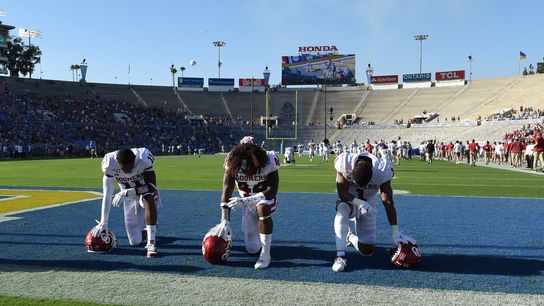This isn't going to be a pretty story for the Pac-12, but if you've been paying attention you know that already.
Earlier this week, the great Jon Wilner of the San Jose Mercury-News reported that the Pac-12 will report $33 million in revenue per school later this year, which sounds great on paper until you realize it's not 2012 anymore. Just last week the SEC announced it distributed $44.6 million per school over the 2018-19 fiscal year, a 33 percent gap that, according to Wilner, will accumulate into a $100 million difference over just a 5-year period.
The SEC's revenue is set to skyrocket when ESPN/ABC takes over CBS's football package, as each school is projected to earn a $17 million annual raise from its game-of-the-week television package alone.
The Pac-12 isn't set to renegotiate its contracts with FOX and ESPN/ABC until 2024-25, a year after the SEC and Big Ten shake down the networks for all they're worth.
In related news, UCLA athletics ran a $19 million deficit in fiscal year 2019 and needed a loan from the university. Cal has taken $110 million from the university's general fund to support athletics over the past five years, and the Golden Bears recently accepted a $1.9 million guarantee to play at Notre Dame in 2022. Oregon State collected a $1.7 million guarantee for visiting Ohio State in 2018.
Flip the perspective to the other end of the spectrum and the picture becomes even more bleak.
As SB Nation pointed out, Georgia produced more blue-chip 2020 recruits than California. Not more blue-chip recruits when adjusted for population -- more blue-chip recruits, period.
California is the breadbasket that feeds the entire Pac-12, so it should come as no surprise that the Pac-12 did not produce a single top-10 recruiting class and only one -- No. 12 Oregon -- in the top 15.
Pac-12 schools did a decent job keeping California's top talent (16 of the state's top 25 remained out west) but only one -- Corona Del Mar wide receivers John Humphrey, the state's No. 14 player -- signed with a California school.
While Oregon, Washington (No. 16), Stanford (No. 21), and Utah (No. 29) did about as well as one could reasonably expect them to do, USC (No. 55) is not coming close to pulling its weight as the conference's flagship program.
Much like the financials, the trends aren't getting better for the Pac-12 here, either.
While it's true that high school football participation is dropping nationwide, California's participation is falling at a rate greater than the national average.
In 1998, when the state's population was 32.68 million, 91,301 Californians played high school football.
In 2018, with the state's population approaching 40 million, 91,305 Californians played high school football.
Likewise, attendance is falling across the board in major college football, but it's falling faster in the Pac-12 than elsewhere.
While Pac-12 commissioner Larry Scott has become a convenient punching bag -- his bet to build an independent conference TV network rather than partner with ESPN or Fox has proven to be a failure -- no administrator can overcome the underlying truth: people out West don't care about football as much as they do in the South and the Midwest.
Actually, let me state that more diplomatically: there aren't as many people who care deeply about football on the West Coast as there are in the South and the Midwest.
Combine the two above trends and you get, well, what you've gotten on the field in recent years:
-- The Pac-12 has produced two College Football Playoff participants in six years under the new system, and none in the past four years.
-- The Pac-12 hasn't won a national championship since USC in 2004. (The league's last men's basketball title: 1997 Arizona.)
-- The Pac-12 hasn't placed two teams in the year-end AP Top 10 since 2016. Over the 2017-18 seasons, the conference produced a single AP Top 10 finisher -- No. 10 Washington State in 2018.
AP Top 10 Finishers, 2017-19
1. SEC -- 11
2. Big Ten -- 7
3. Big 12 -- 4
4. ACC -- 3
5. Pac-12 -- 2
6. American, Notre Dame -- 1
Now, these numbers aren't manifesting themselves in the Pac-12's overall talent level. At least, not yet. The league produced 2.73 NFL draft picks per school from 2016-19, second only to the SEC.
None of this is to say the 2020 version of Pete Carroll couldn't ignite a new Trojan reign at USC. (Is this a good time to mention only one Pac-12 head coach, Washington State's Nick Rolovich, was a sitting head coach when he joined the conference?) In fact, take out Clemson and the ACC would be suffering from may of the same ills affecting the Pac-12 right now.
So, yes, much of this can be blamed on USC not pulling its weight. Oregon, Washington, Utah, each of them is operating at peak capacity or close to it. USC hasn't been close lately.
But even a coach as gifted as Pete Carroll, Howard Jones and John McKay combined couldn't make up a $20 million revenue gap per school, per year, and he couldn't convince tens of thousands of California teens to go out for their school's football team.
